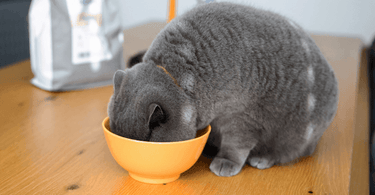You may be surprised to learn that there are 12 types of cat food available on the market - usually we think of wet, dry and more recently fresh food. But within these categories there are multiple different ways in which cat food can be made. Some types of cat food have been around since as early as the 1860s! And others are relatively new, having launched in the past 2 to 3 years as part of the trend to humanise pets. With so many options available to you, it’s hard to know if you’re making the right choice for your cat and what trade offs you may be making. In this article we’ll look at each type of cat food, how it’s made and what the pros and cons of it are.
Understanding pet food preservation methods
To understand some of the key differences between different types of cat food, you first need to understand one of the key processes all cat food goes through: preservation.
Why do we need to preserve cat food?
- Safety: to eliminate microbes, destroy toxins, spores and prevent spoilage. All of these prevent your cat contracting a foodborne disease such as salmonella or E.Coli
- Prolong shelf-life: to allow for seasonality of ingredients, store in case of shortages and convenience for cat owners
- Maintain food quality: from colour, texture and odour- all these things make the food appealing to your cats
- Reduce food waste: and in turn reducing carbon footprint as well as disposal costs
How do cat food manufacturers preserve cat food?
There are three main ways in which cat food is preserved:
- Temperature: through freezing or heating food. At certain temperatures sterilisation occurs and most bacteria is destroyed. It’s important to know that at some moderate temperatures (~50 degrees celsius) bacteria can survive and some will even thrive. We’ll come onto why this is important later.
- pH: acidic pH enables both pasteurisation and sterilisation (depending on the pH) and so some cat food will contain ingredients that will help obtain both an optimal pH for preservation as well as urinary tract health (which is also very much impacted by the pH of the food).
- Water: Certain levels of moisture in cat food allow for microbial growth
Cat food manufacturers will generally use a combination of all three preservation methods to ensure the food is safe for your cat and still maintains the ideal texture, colour, smell and taste to be highly palatable for your cat - aka tasty!
What are the 12 types of cat food?
Dry baked cat food
Preserved through low moisture content and cooked to a minimum temperature of 90 degrees Celsius, dry baked cat food comes in solid shapes or in a crumb and is made by batch baking a dough-like mix. They have a long shelf life of around 12-18 months at ambient temperature. Most dry baked cat foods are complete.
Dry baked cat food first came to the market in the 1860s.
Dry flaked cat food
This is made by applying steam to whole grains like, maize, barley or oats. The starches are gelatinised in this process and then flaked. This type of cat food is cooked to 90 degrees Celsius and has a long shelf life of 18 months at ambient temperature. Again, dry flaked cat food is complete however, it’s not seen on the market much anymore.
Dry flaked cat food first came to the market in 1953.
Dry extruded cat food
This is also known as kibble and is the most popular dry cat food on the market. Kibble is an excellent option for cat food if high quality ingredients are used. These ingredients are conditioned with steam and extruded under pressure. It is dried in the oven, enrobed in an oil or perhaps a crumb and then cooled and packed. Traditionally extruded kibble has been cooked to high temperatures such as 90 degrees Celsius, however modern technology means that some newer kibble is cooked slowly at a slightly lower temperature of 70 degrees Celsius to protect the proteins, ensuring maximum digestibility and bioavailability of the nutrients. Extruded kibble may require additional preservatives due to the moisture content. Tippaws Delicious Dry Food is cooked in this more modern way of extrusion and rosemary is added as a natural preservative. The shelf life of dry extruded food is 12-18 months at ambient temperatures.
Dry extruded cat food first came to the market in 1956.
Semi-moist cat food
This cat food may be baked or extruded and will contain humectants, preservatives and acidifying agents. It is cooked to 90 degrees Celsius but the higher moisture content may mean that this food is susceptible to spoiling which is why preservatives will almost always be added. The shelf life of this food is 12-18 months.
Semi-moist cat food first came to the market in 1960.
Sterilised wet food
This is the most common wet food on the market and will be what you will recognise as tinned wet food or wet food that comes in aluminium trays, plastic trays or pouches. It must be cooked in both moisture and air tight containers and moisture is retained in the tin because it will be hermetically sealed. In the UK, the core temperature of tinned food must reach 121 degrees Celsius for 3 minutes or the equivalent (e.g. higher for shorter or lower for longer). You can get complete sterilised wet food in many forms from chunks in gravy, to terrines, chunks in jelly, pates and mousses. You can also get complementary cat food in these forms as well as shreds and soups which are more popular these days.
Sterilised cat food first came to the market in 1922.
Cold-pressed cat food
This type of cat food is made from ground raw ingredients that are pushed through the holes in the side of a drum to make pellets. It is cooked at low temperatures of 43-46 degrees Celsius which makes it slightly concerning as these are the temperatures in which microbes and bacteria will thrive. The shelf life of these foods is 8-9 months.
Cold-pressed cat food first came to the market in the 1980s.
Air-dried cat food
This is made from raw, chilled ingredients which have heat blown over them to remove moisture. They are then cooked on a gentle heat of ~40 degrees Celsius for several days or warm air is blown over them for hours at a higher temperature of 60-90 degrees Celsius. The shelf life of these foods is 18-24 months and could also be a concern if the higher temperatures are not reached during the cooking process (e.g. low temperature gentle cooking only). These come in bags and pouches.
Air-dried cat food first came to the market in the 2000s.
Freeze-dried cat food
This was designed as a safer alternative to raw food but the process doesn’t actually stop the microbes from being present. Raw, chilled ingredients are frozen and moisture is extracted from them under vacuum. They’ll usually come in pouches or tubs and have a shelf life of 20+ years.
Freeze-dried cat food first came to the market in the 2010s.
Fresh chilled cat food
This food is heat-processed within sealed packaging and then chilled. It is cooked to around 70-90 degrees celsius and will usually come in pouches or plastic trays. It is considered to be a pasteurised product. The shelf-life of fresh chilled cat food is around 14 days in the fridge.
Fresh chilled cat food first came to the market in the 2017.
Fresh frozen cat food
This food is heat-processed within sealed packaging and blasted frozen. It comes in plastic trays or pouches and steam cooked at 70-90 degrees celsius. As it is frozen the shelf life is around 1 year.
Fresh frozen cat food first came to the market in 2020.
Sous-vide cat food
This food is heat-processed within a vacuum pack and either blasted frozen or chilled. This is a modern way of cooking cat food that has become trendy with new brands in the past few years. It is cooked in a water bath at 55-60 degrees celsius for 72 hours. This is concerning as the temperature does not get high enough to kill all the bacteria in the pouches and so could be dangerous for cats. The shelf life of this type of food is 8 weeks frozen or 3-4 weeks chilled. Some experts in the industry really worry about the safety of this food given the high moisture, low cooking temperatures and higher pH.
Sous-vide cat food first came to the market in 2019.
Raw frozen cat food
This food hasn’t undergone any preserving process other than chilling or freezing. It can come in the form of nuggets, medallions, minces or mixed meals. It is frozen at -18 degrees celsius and has a shelf life of 3-6 months in the freezer.
Raw frozen cat food first came to the market in the 2020s.
Which is better, traditional or new types cat food?
There is currently no evidence to suggest that new types of cat food such as sous-vide are any better than traditional food formats such as kibble or tinned wet food. New companies generally quote qualitative research from their own customer base when making claims vs. scientific research by expert nutritionists so it tends to be biased. The most important thing is to have safe, efficacious and delicious food for your cat which most traditional types of cat food do provide. It’s also important to give your cat a food that is sold by a company which is part of UK Pet Food due to the quality and ethical standards they must adhere to.
Subscribe to our newsletter to get 10% off your first order.

